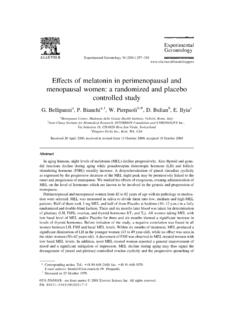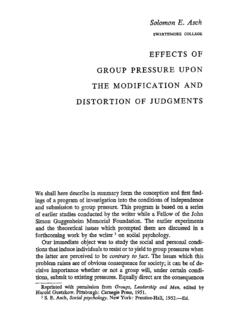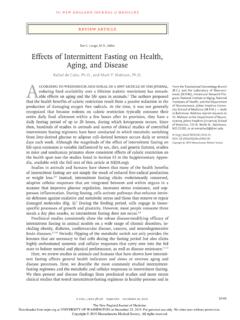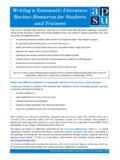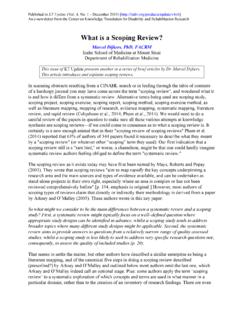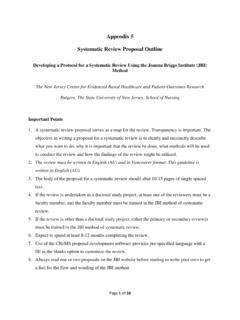Transcription of The negative Flynn Effect: A systematic literature review
1 The negative Flynn effect : A systematic literature reviewEdward Duttona, , Dimitri van der Lindenb,RichardLynncaUlster Institute for Social Research, London, UKbErasmus University Rotterdam, Department of Psychology, Education, and Child Studies, The NetherlandscUniversity of Ulster, London, UKabstractarticle infoArticle history:Received 18 January 2016 Received in revised form 9 September 2016 Accepted 13 October 2016 Available online xxxxThe Flynn effect (rising performance on intelligence tests in the general population over time) is now anestablished phenomenon in many developed and less developed countries. Recently, evidence has begun toamass that the Flynn effect has gone into reverse; the so-called negative Flynn effect . In this study, we presenta systematic literature review , conducted in order to discover in precisely how many countries this reverse phe-nomenon has been uncovered.
2 Using strict criteria regarding quality of the sample and the study, we found ninestudies reporting negative Flynn Effects in seven countries. We also discuss several possible explanations for thenegative Flynn effect as an attempt to understand its most probable causes. 2016 Elsevier Inc. All rights : negative Flynn EffectIQ declineDysgenicsImmigration1. IntroductionNumerous studies have shown that scores on intelligence tests ( ,IQtests) havesubstantially increased duringmuch of thetwentiethcen-tury. This increase in IQ scores wasfirst reported in the United States byRunquist (1936)and was later confirmed bySmith (1942)andTuddenham (1948).Cattell (1951)reported a similar trend in Englandafter it became apparent that the increase in IQ scores was a largelyglobal phenomenon found in many different countries (summarizedinLynn, 2013).
3 This phenomenon has been designatedthe Flynn Effectafter the re-view byFlynn (1984, 1987, 2012)whofirst documented it on theStanford-Binet and Wechsler tests. A Flynn effect is distinct from simplesamplefluctuations in IQ scores in annually assessed cohorts. More spe-cifically, the effect is understood to be established if there is an overallincrease in IQ score, rather than merely an increase on one IQ domain( , verbal or spatial ability), and if the increase is continuous overmany years or over a relatively long period of time. In this regard, Flynn (1984)found there had been a point increase in IQ scores be-tween the years 1932 and 1978, amounting to a rise of points peryear or 3 points per decade. More recently, the Flynn effect was furtherevidenced by calculations of IQ score gains between 1972 and 2006 onversions of the Stanford-Binet (SB), Wechsler Adult Intelligence Scale(WAIS), and Wechsler Intelligence Scale for Children (WISC) ( Flynn ,2009).
4 The Flynn effect ( Flynn , 2012) is not only occurring in developedcountries, but it is increasingly being found in developing countries aswell, such as Kenya, Turkey, Dominica, Saudi Arabia, China and Sudan(seeFlynn, 2012). The effect has been found in Latin America, for exam-ple Brazil (Colom, Flores-Mendoza, & Abad, 2007)andArgentina( Flynn & Rossi-Case, 2012) and in the former Communist Bloc ( Estonia;Must, Must, & Raudik, 2003). The average global increase of 3 IQ pointsper decade has also been confirmed in a recent meta-analysis byPietschnig and Voracek (2015).Although one criterion of the Flynn effect is that it applies to the fullIQ score, it should be noted, that it nevertheless is driven more stronglyby rises on certain kinds of ability. Relative to scores produced by verbaltests, there have been greater gains in scores produced by nonverbal,performance-based measures like Raven's Progressive Matrices andWechsler performance subtests ( Flynn , 2012).
5 These types of tests areassociated withfluid intelligence, suggesting less of a rise in crystalizedintelligence (which reflects the influence of education, such as vocabu-lary). A notable exception is the increasing scores produced by theWechsler verbal subtest Similarities, although this subtest relates to el-ements of reasoning not required by the other subtests comprising theWechsler Verbal IQ Flynn effect means that an individual in the most recent cohortwill attain a higher IQ score when set against the norms of an earlier co-hort than he will when set against his own. Accordingly, it means thatthe test will overestimate a subject's IQ by an increasing amount thelonger the time-span is between the norming of the test and its admin-istration. This has clear practical implications for any organization thatseeks to use an IQ test for any purpose.
6 Indeed, Flynn (2012)hashighlighted the problem of US states having rules whereby those whoare mentally retarded cannot be executed if found guilty of murder. Ifthe test from which their IQ score was gleaned, such as a test at school,was not appropriately normed then it will not provide them with thecorrect IQ score and, accordingly, an intellectually impaired personIntelligence xxx (2016) xxx xxx Corresponding Dutton).INTELL-01164; No of Pages 7 2016 Elsevier Inc. All rights lists available atScienceDirectIntelligencePlease cite this article as: Dutton, E., et al., The negative Flynn effect : a systematic literature review ,Intelligence(2016), be executed. This example, provided by Flynn , however, also im-plies that the increase in IQ scores may not be a genuine increase in in-telligence. This notion is in line with more recent studies that havesuggested that increases in IQ scores may not necessarily reflect an in-crease in the latent intelligence factor,g(te Nijenhuis, van Vianen, &van der Flier, 2007; te Nijenhuis & Van der Flier, 2013).
7 All in all, theFlynn effect is an important phenomenon in the study of intelligenceand , however, a number of prominent studies have reported areversal in the Flynn effect , beginning in the latter decades of the twen-tieth century. A number of these studies ( , Barlaug, &Torjussen, 2004) draw upon annually accrued conscript military data,which involves the vast majority of the nation's males in any given an-nual cohort. Accordingly, they allow us to conclude that there is a con-tinuous decline in IQ scores over time and that this is a realphenomenon and not simply a recently, a negative Flynn effect has also been reported in anumber of other countries, such as France (Dutton & Lynn, 2015). In ad-dition, a series of studies have noted declines in proxies for intelligence,such as in the lengthening of reaction times between 1900 and 2000(Woodley, te Nijenhuis, & Murphy, 2014), a decline in colour discrimi-nation ability (Woodley, te Nijenhuis, & Murphy, 2015) and a rise influctuating facial asymmetry (Woodley & Fernandes, 2016), somethingwhich has been shown to be weakly negatively correlated with intelli-gence.
8 These sets offindings by Woodley and colleagues seem to indi-cate that approximately a century ago, a decline in the latent factor ofgenuine intelligence began, which until now has largely been cloakedby an increase in scores on IQ tests. Yet, with the increase in IQ scoresslowing down (seePietschnig & Voracek, 2015) or even going into re-verse, the decline ingmay start to become apparent on IQ et al. (2015)term this the co-occurrence model which statesthat the Flynn effect occurs on the more environmentally influencedand less g-loaded aspects of intelligence, while dysgenics concomitantlyoccurs on the more g-loaded and more heritable there truly is a trend toward declining intelligence as indicated bya negative Flynn effect then this would be a phenomenon with poten-tiallyserious implications. This is because there is evidence that nationalIQis associated with economic prosperity(Lynn& Vanhanen,2012), po-litical stability (Lynn & Vanhanen, 2012)andscientificachievement(Rindermann & Thompson, 2011).
9 Therefore in the present study, wewish to establish in precisely which countries there has been a reportednegative Flynn effect . We aim to do this by conducting an exhaustiveand systematic literature search, as we will outline below. We thenwish to establish its most likely causes and to address any possibleanomalies. In order to establish this, we conducted a systematic litera-ture review the details of which we will now literature searchIn conducting this review , we followed the PRISMA guidelines( ). We decided to use the followingeligibility criteria for including studies in the review :(1) The study related to a population sample, or a sample likely to berepresentative of the country's population.(2) A negative Flynn effect was noted over a considerable period oftime, which was set at 5 years. It is appreciated that this borderinvolves some degree of arbitrariness.
10 This amount of time wasselected, however, because, from the studies of which we werealready aware showing a negative Flynn effect , there had neverbeen a rise in scores after 5 years of decline.(3) The effect had to be on an IQ test, rather than on some proxy forthis such as a scholastic test. This is very important, such that wewere comparing like with like. The Flynn effect was observed onIQ tests and this restriction had to be adhered to.(4) It had to be an overall decline in IQ score on the test, rather thansimply a decline restricted to one of its domains. Again, this is anessential dimension to the Flynn effect itself and must thereforebe employed in any analysis of the reversal of this effect .(5) It had to be original research. Articles which cited other articleswere ruled on these criteria we searched for the literature using the fol-lowing Prisma procedure.




